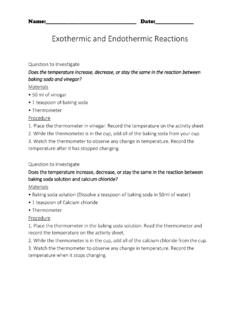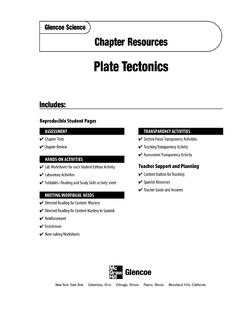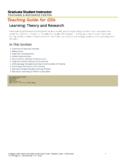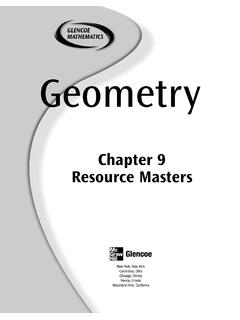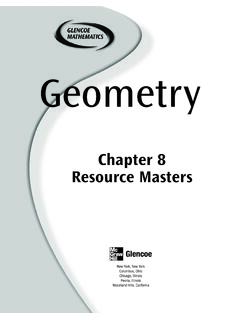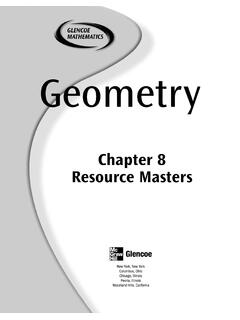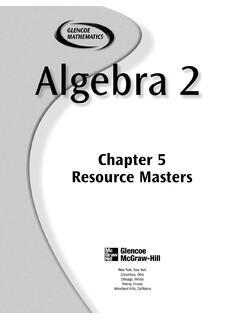Transcription of SECTION IDENTIFYING DNA AS THE GENETIC MATERIAL 8.1 …
1 DNA AS THE GENETIC MATERIALS tudy GuideKEY CONCEPTDNA wasidentified asthe GENETIC MATERIAL through aseriesof IDEA:Griffith findsa transforming principle. Write the results of Griffith s experiments in the boxes mice with R bacteria mice with S bacteria S bacteria and injected them into mice killed S bacteria with R bacteria and injected them into mice Found live S bacteria in the mice s blood Results typeof bacteria caused disease, the S form or the R form? conclusions did Griffith makebased on his experimental results?Unit 3 Resource BookStudy Guide61 McDougal Littell BiologyCopyright McDougal Littell/Houghton Mifflin 8 From DNA to ProteinsSTUDY guide , CONTINUEDMAIN IDEA:Avery identifiesDNA asthe transforming and his team isolated Griffith s transforming principle and performed three teststo learn if it was DNA or protein.
2 In the table below, summarize Avery s work by writingthe question he was asking or the results of his s QuestionResultsWhat type of molecule does the transformingprinciple contain?The ratio of nitrogen to phosphorus in thetransforming principle is similar to the type of enzyme destroys the ability ofthe transforming principle to function?MAIN IDEA:Hershey and Chase confirm that DNA isthe GENETIC containbut very containsbut the two experiments performed by Hershey and Chase by completing thetable below. Identify what type of radioactive label was used in the bacteriophage andwhether radioactivity was found in the 1 Experiment 2 Vocabulary what a bacteriophage is and describe or sketch its GuideUnit 3 Resource BookMcDougal Littell BiologyCHAPTER 8 From DNA to ProteinsCopyright McDougal Littell/Houghton Mifflin DNA AS THE GENETIC MATERIALP ower NotesGriffith s experiments:Conclusion:Avery s experiments: Conclusion:Hershey and Chase s experiments: Conclusion.
3 Unit 3 Resource BookPower Notes63 McDougal Littell BiologyCopyright McDougal Littell/Houghton Mifflin 8 From DNA to DNA AS THE GENETIC MATERIALR einforcementKEY CONCEPTDNA was identified as the GENETIC MATERIAL through a series series of experiments helped scientistsrecognize that DNA is the GENETIC of the earliest was done by Frederick Griffith who was studying two forms of thebacterium that causes pneumonia. The S form was surrounded by a coating that madethem look smooth. The R form did not have a coating, and the colonies looked injected these bacteria into mice and found that only the S type killed the the S bacteria were killed, they did not cause the mice to die. However, whenkilled S bacteria were mixed with live R bacteria, the mice died and Griffith found liveS bacteria in their blood.
4 This led Griffithto conclude that there was a transformingprinciple that could change R bacteria into S Avery, another scientist, developed away to purify this transforming then conducted a series of chemical tests to find out what it was. Many scientiststhought that DNA was too simple of a molecule to be the GENETIC MATERIAL and thatproteins, being more complex, were a better candidate. However, Avery made three keydiscoveries about his samples of transforming principle that showed otherwise: DNA was present, not protein. The chemical composition matched that of DNA, not protein. The addition of enzymes that break down DNA made the transforming principleinactive. The addition of enzymes that break down proteins or RNA had no Hershey and Martha Chase carried out the final, conclusive experiments in viruses that infect bacteria and take over bacteria s GENETIC machineryto make more viruses.
5 They consist of a protein coat surrounding DNA. Hershey andChase grew these viruses in cultures containing radioactively labeled sulfur, a componentof proteins, or phosphorus, a component of DNA. Bacteria were then infected withviruses that either had radioactively labeled sulfur or phosphorous. Hershey and Chasenext separated the viruses from the bacteria with a blender. The bacteria had radioactivephosphorus but no radioactive sulfur. Hershey and Chase concluded that the viruses DNA, but not the protein coat, had entered the was transformed in Griffith s experiment? molecule had entered the bacterium in the Hershey-Chase experiments, sulfur orphosphorus? Which molecule is a major component of DNA?64 ReinforcementUnit 3 Resource BookMcDougal Littell BiologyCHAPTER 8 From DNA to ProteinsCopyright McDougal Littell/Houghton Mifflin OF DNAS tudy GuideKEY CONCEPTDNA structure isthesame in all pairing rulesdouble helixMAIN IDEA:DNA iscomposed of four typesof the space below, draw a nucleotide and label its three parts using words and many types of nucleotides are present in DNA?
6 Parts are the same in all nucleotides? Which part is different?MAIN IDEA:Wa tson and Crick developed an accurate model of DNA did Franklin s data reveal about the structure of DNA? did Watson and Crick determine the three-dimensional shape of DNA?Unit 3 Resource BookStudy Guide65 McDougal Littell BiologyCopyright McDougal Littell/Houghton Mifflin 8 From DNA to ProteinsSTUDY guide , does DNA base pairing result in a molecule that has a uniform width?MAIN IDEA:Nucleotidesalwayspair in thesame nucleotide pairs with T? with C?In the space below, draw a DNA double helix. Label the sugar-phosphate backbone, thenitrogen-containing bases, and the hydrogen how the DNA double helix is similar to a spiral do the base pairing rules relate to Chargaff s rules?66 study GuideUnit 3 Resource BookMcDougal Littell BiologyCHAPTER 8 From DNA to ProteinsCopyright McDougal Littell/Houghton Mifflin OF DNAP ower NotesBondingBase pairing rules:Chargaff s of aDNA moleculeNitrogen-containing basesBackboneOverall shape:AGTCTCAGUnit 3 Resource BookPower Notes67 McDougal Littell BiologyCopyright McDougal Littell/Houghton Mifflin 8 From DNA to OF DNAR einforcementKEY CONCEPTDNA structure is the same in all is a chain of nucleotides.
7 In DNA, eachnucleotideis made of a phosphate group,a sugar called deoxyribose, and one of four nitrogen-containing bases. These four basesare cytosine (C), thymine (T), adenine (A), and guanine (G). Two of the bases, C and T,have a single-ring structure. The other two bases, A and G, have a double-ring scientists had a good understanding of the chemical structure of DNA by the1950s, they did not understand its three-dimensional structure. The contributions ofseveral scientists helped lead to this important discovery. Erwin Chargaff analyzed the DNA from many different organisms and realized thatthe amount of A is equal to the amount of T, and the amount of C is equal to theamount of G. This A = T and C = G relationship became known as Chargaff s rules. Rosalind Franklin and Maurice Wilkins studied DNA structure using x-raycrystallography.
8 Franklin s data suggested that DNA is a helix consisting of twostrands that are a regular, consistent width Watson and Francis Crick applied Franklin s and Chargaff s data in building athree-dimensional model of DNA. They confirmed that DNA is adouble helixinwhich two strands of DNA wind around each other like a twisted ladder. The sugar andphosphate molecules form the outside strands of the helix, and the bases pair together inthe middle, forming hydrogen bonds thathold the two sides of the helix together. Abase with a double ring pairs with a base with a single ring. Thus, in accordance withChargaff s rules, they realized that A pairs with T, and C pairs with G. The bases alwayspair this way, which is called thebase pairing did Chargaff s rules state? did Franklin s data show about the three-dimensional structure of DNA?
9 Forms the backbone strands of the DNA double helix? What connects thesestrands in the middle?68 ReinforcementUnit 3 Resource BookMcDougal Littell BiologyCHAPTER 8 From DNA to ProteinsCopyright McDougal Littell/Houghton Mifflin REPLICATIONS tudy GuideKEY CONCEPTDNA replication copiesthe GENETIC information of a polymeraseMAIN IDEA:Replication copiesthe GENETIC is DNA replication? does DNA replication take place in a eukaryotic cell? is DNA replicated during the cell cycle? does DNA replication need to occur? is a template? one strand of DNA had the sequence TAGGTAC, what would be the sequence ofthe complementary DNA strand?MAIN IDEA:Proteinscarry out the processof roles do proteins play in DNA replication? must be broken for the DNA strand to separate? is DNA replication called semiconservative?
10 Unit 3 Resource BookStudy Guide69 McDougal Littell BiologyCopyright McDougal Littell/Houghton Mifflin 8 From DNA to ProteinsSTUDY guide , CONTINUEDUse words and diagrams to summarize the stepsof replication, in order, in the boxes IDEA:Replication chromosomes have hundreds of, where the DNA isunzipped so replication can polymerase has afunction that enables it to detect errorsand correct what DNA polymerase is by breaking the word into its a short analogy to explain what replication sometimes like to display bumper stickers that relate to their trade or field ofstudy. For example, a chemist may have a bumper sticker that says It takes alkynes tomake the world. Then, chemists or other people who know that an alkyne is a moleculethat contains carbon atoms joined by a triplebond get a nice little chuckle out of theplay onwords.


